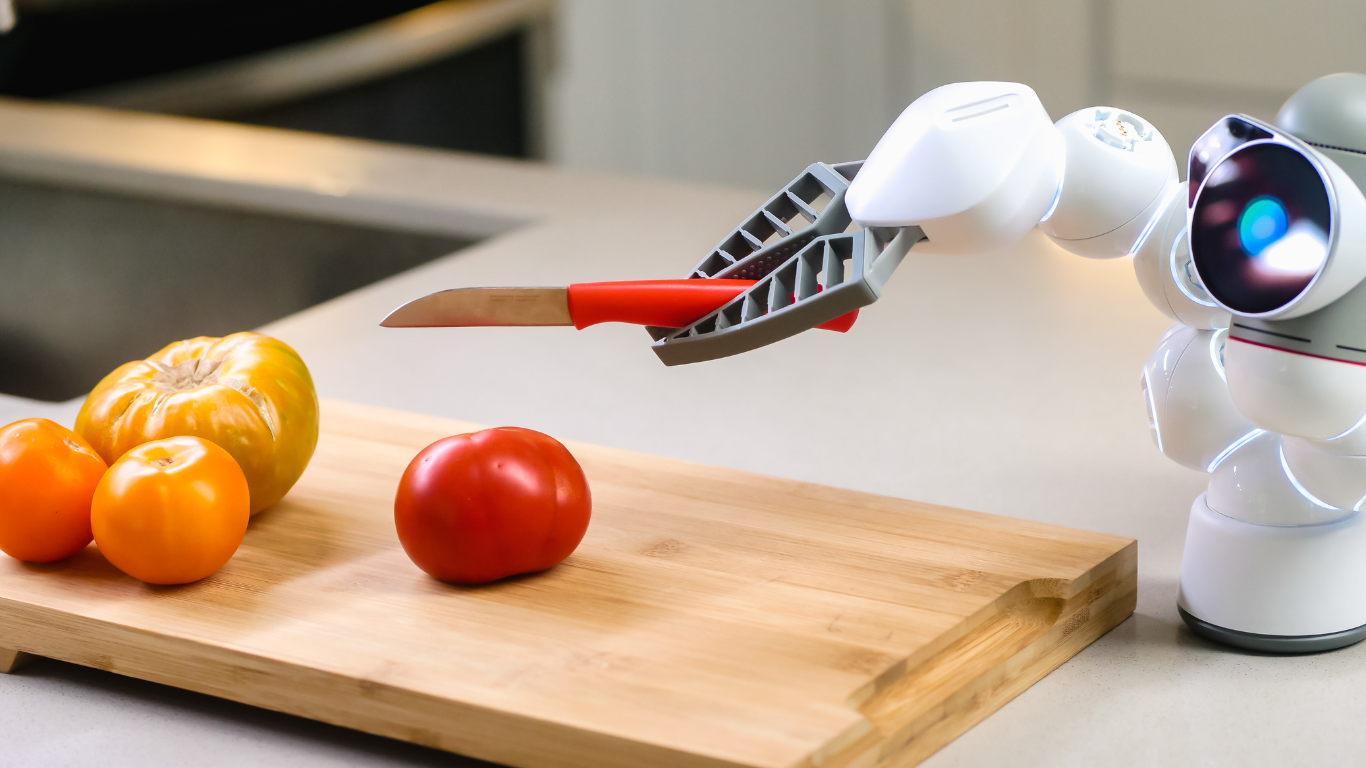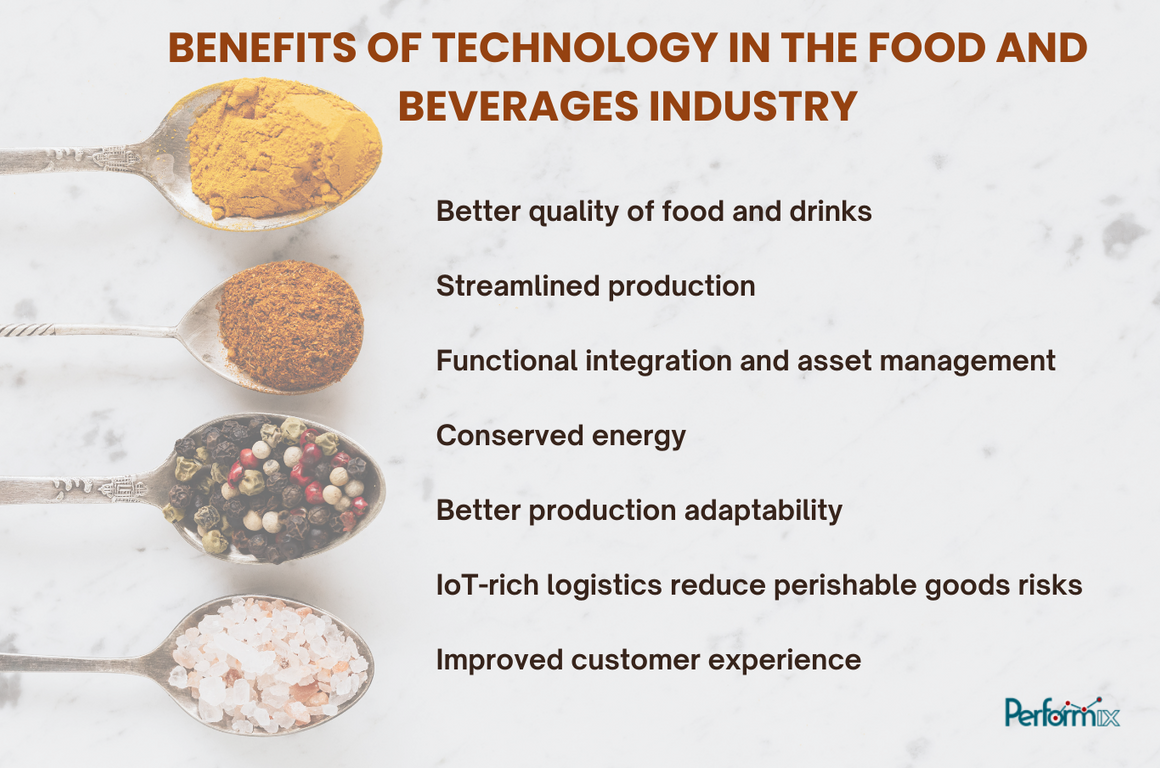Technology serves as the answer!
The F&B industry had an incredibly difficult 2020. At the height of the COVID-19 pandemic, several businesses experienced substantial losses due to disruptions in logistics, supply chains, deliveries, etc. This has changed the food and beverage sector trends, and watching how the industry adapts to technological advances is engrossing.
There is a wide variety of opportunities and threats for the food and beverage industry brought about by the advent of digital technology and the growth of Industry 4.0. Due to the increased ubiquity of modern production techniques, manufacturers of all sizes offer contactless home delivery of hygienically packaged products, from significant factories to tiny chefs and stores. Following the conclusion of the pandemic, the food and beverage industry rethought how to apply cutting-edge technologies to make itself more resilient in the face of the challenges of the modern world.
Why food and beverage makers need digital innovation
In today’s lightning-fast society, advances in any field often appear to have occurred overnight. The food business provides an obvious example of how consumer needs and emerging technologies are intertwined. As consumers make their wants known, business magnates can develop innovative solutions. The result is food that is better for you, easier to find, and more considerate.
1. Healthy Food
As the world’s population has risen, so requires food. About 43 percent of shoppers across the globe are actively seeking out healthier and more secure food options. Manufacturers cannot simply boost output to meet rising global demand. Current rules in the food and beverage industry highlight the significance of safe and healthy food choices, which need to be taken into account by these businesses. So, several companies have implemented technological solutions to increase output and distribute better options.
2. Global Warming
Climate change has emerged as a significant threat in recent years. As a result, people everywhere are doing what they can to safeguard Earth. Vegetarianism and veganism are part of this movement, as is the push for more eco-friendly product production. These businesses can demonstrate their commitment to sustainability in their manufacturing processes by embracing digital transformation and increasing transparency.
3.Non-degrabable goods
Similarly, consumer concern about the environment has expanded to include packaging. Many grocery store items are packaged in plastic, which you can see as you peruse the aisles. Using plastic items is terrible for the environment.
One good thing is that people are turning away from plastic in large numbers, which has led some companies and even whole countries to ban things like plastic straws and cutlery. As a result, new approaches have emerged, with the digital realm offering novel ways to address the issue.
4. Competitiveness
Five manufacturers likely offer nearly identical prices. It’s common knowledge that differentiation among businesses is essential to success in today’s business climate. Technology has become the go-to tool to level the playing field because most consumers value innovative strategies and services.
Technological advancements in the F&B industry
Smart technology speeds up food safety processes
Professionals in the food and beverage industry constantly worry about ensuring their products are safe and in line with applicable regulations. Four organizations are responsible for making and enforcing rules within their respective industries.
- The Food and Drug Administration (FDA)
- The Food Safety and Inspection Service (FSIS)
- The Environmental Protection Agency (EPA)
- National Marine Fisheries Service (NMFS)
Customers have similar expectations since these regulatory organizations are defining norms around operational traceability.
Do you know
A survey found that 94 % of customers are more loyal to a food company that discloses its entire supply chain, while 34 % are open to trying a different brand if necessary.
To their relief, innovative solutions exist to ensure that businesses maintain security and conform to regulations. It includes resources like the Internet of Things-connected sensors that aid supervisors to
- Maintain safe temperatures
- Count inventory
- Examine ingredients
- Facilitate delivery distribution
It is now possible for businesses to quickly develop and distribute checklists via a variety of digital platforms, including mobile apps and web-based tools. Instead of keeping track of audits and findings on paper, companies can do so much more with these lists. Additionally, they can stay automatic timestamps of significant events and modifications.

Food production through robots
Companies in the food and beverage industries need intelligent machinery to keep up with rising food output. Robotic machines can benefit line workers today. Due to their speed and safety, they replace humans in dangerous tasks. For instance, robotic butchers can prepare complex meat cuts in factories, freeing human butchers for safer work. Robots can control everything from sorting the raw materials, cleaning, production, and packing to labeling.
Digital technology that connects different equipment and systems is a must if you want to run a more efficient manufacturing operation. Also, it can boost productivity by cutting down on unplanned maintenance and making the use of existing assets more efficient.
Using AI to improve predictions
Productivity and market demand are inseparable. Instead of using manual reports and projections to guess what your customers will do next, go with AI. Employing AI-powered software makes forecasting, demand tracking, and supply orders easier. This eliminates the possibility of cost and time overruns.
Because of this, influential people in the F&B industry are looking more and more to inventory management systems to help them do the following:
- Estimate the best times to place orders
- Get rid of high food prices
- Maintain a constant supply of goods.
- Reduce the likelihood of catastrophic events like overages and holdups
Blockchain for enhancing food chain supply
When an industry grows as worldwide as the food and beverage sector, supply chain management becomes increasingly complicated and fraught with challenges. Blockchain is a new decentralized information technology that could help the food supply chain. It has the potential to cut down on transaction times and costs while increasing process transparency, efficiency, security, and trust.
Drones to study crop production
Climate and soil quality are crucial to the agricultural industry. Workers in the food business would have to manually verify crops for quality, if not for new technological advancements. This job needs to be done with precision and accuracy. Humans can make more nuanced judgments about the environment, but technology can help make this job more manageable.
Several businesses have begun utilizing drones as a solution to problems. The equipment can survey the land from the air. It helps save time and increase output by inspecting soil and crops. Insights like this about the soil’s quality allow the enterprise to produce nutritious food.

F&B is a fascinating field where we see constantly evolving developments and inventions tailored to the public’s preferences. The technologies mentioned above are prevalent now, and their advancements are never-ending. In light of consumers’ growing interest and concern about the food’s origins and preparation methods, producers have improved their offerings with these technological advancements.
Visit the technological solutions that Performix offers for the Food and Beverage Industry, and then start a free discovery call to discuss the areas in which you would like us to assist you.
Although leaders/investors are enthusiastic about the digital revolution, this industry is volatile, especially post-COVID. Inflation has shaken the confidence of many businesses, making them wary of making F&B investments. But, have no fear. To protect your business from escalating inflation, we offer quick tips to stay secure amid price increases.
How to set up a risk management plan in 3 easy steps
Producers, manufacturers, distributors, logistics experts, and other vital stakeholders are under intense pressure to increase output rates without compromising product quality. Consequently, this industry is essential to business, as it must ensure consumer satisfaction, food safety, and sustainable practices among ever-changing norms and regulations.
This is why F&B companies need to use a risk management tool that covers everything. Begin with
1. Uncover potential risks with risk management software
Risk management tools can help food and beverage firms reduce threats by reducing chance and impact. The software can assess risk and generate reports and dashboards to identify “lurking” hazards. The program can guarantee that preventative and corrective steps are taken appropriately.
An effective risk management platform will include flexible processes to accommodate several risk strategies, including capturing and classifying risks by type, status, probability, impact, and exposure. For instance, the Failure Mode Effect Analysis (FMEA) helps the food and beverage industry by assessing potential issues’ likelihood, severity, and detectability.
Additionally, software engineering and testing can benefit from risk management strategies as much as the food and beverage industry. Risk-based testing is a methodology for determining which tests should be run to minimize risk, and it is specifically tailored to the software testing context. It is only possible to test everything thoroughly, especially in a dynamic sector like the food and beverage industry; this method helps testers zero in on the areas where their efforts will have the most significant long-term impact.
2. Identify Key Stakeholders
After choosing a risk management solution, you must identify the people in your organization who will ensure food safety and quality and comply with legislation. Everyone from operations to maintenance is involved in production. To report high-risk locations, find these people. This includes training CEOs and leaders and identifying the most significant risks.
3. List and rank the largest risks
Improving your risk management plan should begin with your frontline employees. Most software will reveal that the most significant dangers are related to commonplace activities like equipment handling, ingredient labeling, health codes, and personnel cleanliness. Verify that personnel has received adequate training on health and safety practices and how to use all necessary equipment before production can begin.
Additionally, many risk management technologies emphasize areas of non-compliance, allowing brands to adhere to regulations more. Using technology to fix problems quickly is especially important for the food and beverage industry because problems can quickly escalate if left unchecked. Risk management technology is essential for problem-solving, but it’s also an excellent tool for seeing new opportunities and anticipating market shifts by mining risk data from the past.
In a high-pressure, fast-paced production setting, mistakes are inevitable. One misstep can have disastrous consequences in a rapidly changing business like food and beverage production, which must adhere to the FDA’s stringent standards due to the potential for severe adverse reactions to certain ingredients. To maintain compliance, the food and beverage industry must have procedures and controls that remove that potential risks.
So, don’t take a chance by ignoring risk management tools! Technology has got solutions for every corner!






